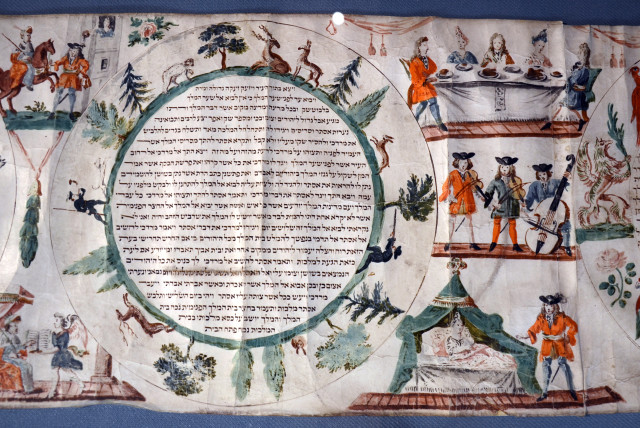A holiday about self-defense: The inconvenient Zionism of Purim - comment

Unable to accept the self-defense message of Purim, radicals want to revise and diminish the holiday to spite Israel.
Jewish holidays are often turned into a mask by anti-Zionist progressive Jews. Hiding behind Jewish aesthetics, they feel they have the freedom to attack Israel and the majority of Jews who are Zionist. Yet while these actors are comfortable wearing the costume of well-known Hanukkah and respectable Passover, they seem to be embarrassed by Purim.
This year there hasn’t been much of a megillah of Purim-themed social media posts advocating on behalf of Palestinians and attacking Israel, likely because the holiday enshrines the right of self-defense, a tenet of Zionism that radical left wing Jews would like to deny to the Jewish state.
Celebrating Purim while Israel is at war
For this reason, Purim 2024 has seen Jews who have taken a more antagonistic position on Israel, creating content attacking the holiday, revising it, and even downplaying how we should perceive the enemies of the Jews.
National Public Radio on Saturday published an article about the “darker chapter” in the Book of Esther, in which the Persian Jews fought back against Haman’s pogromists and killed 75,000 of them.
The Washington Post also published on Purim eve a similar article about how some American Jews were “rethinking Purim celebrations” because this chapter was “particularly uncomfortable in light of the war.”
The Jewish Telegraphic Agency also explored radicals bemoaning the “bloodiest chapter.” Some of the subjects in the articles, such as The Shalom Center’s Chapter 9 Project, even sought to rewrite the over 2000-year-old religious text with new fan fiction endings.
“This year the resonances of Israel-Gaza are too strong to ignore,” rabbi Arthur Waskow wrote in the introduction of the Chapter 9 Project.
In the Purim narrative, Persian vizier Haman hated prominent Jew Mordechai and his people because they did not bow before him, and had laws “different from those of any other people.” Haman obtained permission from king Ahasuerus to perform a genocide of the Jewish people, “to destroy, massacre, and exterminate all the Jews, young and old, children and women, on a single day,” as he put it, and cast a lot for the fateful date of the mass pogrom.
The command went out across the land, and Haman’s men prepared themselves for this dirty deed.
Meanwhile, Mordechai told his niece and crypto-Jew queen Esther, who curried favor with Ahasuerus, to execute Haman and to give permission to the Jews to fight back.
A war of self-defense
On October 7, backed by a Persian regime, Hamas launched a massive pogrom in Israel, murdering, raping, and torturing 1200 people, most of them civilians. Hundreds more were taken into captivity. Israel fought and pushed the pogromists back, and then almost a month later launched a ground invasion to destroy the terrorist organization – an endeavor still ongoing as the 2024 Purim celebrations were held.
In the articles, fringe elements of diaspora Jewry conflated both the Jewish military action against Haman and the one against Hamas forces as vengeance.
Rabbi Amichai Lau-Lavie and rabbi Rachel Timoner, for example, published a March 7 opinion piece in The Forward in which they described the killing of “75,000 civilians, the ultimate collective punishment.” As with the often regurgitated number of Hamas Health Ministry figures of 30,000, non-combatants and combatants are lumped together to obscure the truth.
In the Purim story, the Persian Jews were still in danger after Haman’s execution; Ahasuerus’s orders could not be rescinded. It was fight or die. Since October 7, rockets have continued to fall on Israel, most captives have not been freed, and Hamas has repeatedly said that it would attempt to cast the lots for other “October 7s” in the future.
The Israel-Hamas war, like Purim, is not about vengeance, but preventing impending attacks and justice. Because Hamas and Haman are destroyed ascribable to their own plots – as they justly deserve.
“Let the evil plot, which he devised against the Jews, recoil on his own head,” Ahasuerus said, a statement summed up in modern parlance when social media commentators said Hamas and its supporters “f**ked around, and found out” what the ramifications were for doing so.
Using an advertisement for its interfaith iftar and breaking of the Fast of Esther to call for a “Permanent ceasefire,” Jews for Racial and Economic Justice claimed that “We know unequivocally that responding to violence with massive violence is not the solution and does not make anyone safer,” yet tellingly, they don’t make any arguments tying the protest to Purim.
Military action in the face of a genocidal force saved the Jewish people during the Purim story, and it is within Jewish tradition to follow accordingly.
“What would Esther do?” asked the Shalom Institute, writing new Purim endings in which the war was just Mordechai’s dream, or that Esther magically achieved peace with those that sought to kill her.
Calling for solidarity fast
IfNotNow asked the same question, with the name of their Sunday “Purim for Liberation and Peace,” in which they also imagined alternate endings and called for a ceasefire.
Yet reality cannot just be wished away, and as Esther knew, men like Hamas cannot easily be reasoned with. Esther was not in favor of a ceasefire. After 500 pogromists and Haman’s 10 sons were killed on the first day of the war, Ahasuerus indicated that their deaths may be enough, but Esther pushed the king to allow her people to continue the battle for another day to put an end to the threat – permanently.
Revisionists seek to deny this message of self-defense by claiming that Jewish extremists could use this message to murder innocent civilians. The articles and Shalom Institute essayists invariably cite terrorist Baruch Goldstein, who reportedly justified his murder of Palestinians with the Purim story. Yet Baruch was a unique Purim-inspired radical, acting in the same way that Hamas and its supporters do, targeting civilians.
The Persian Jews and Israel specifically targeted those who raised arms against them. While Ahasuerus gave the Jews license to kill women and children and take their enemies’ belongings, the megillah doesn’t say they did, and explicitly stated they didn’t plunder.
A reasonable message of self-defense should not be tainted by the one example that revisionists all muster. It is doubtful that they would judge an Islamic holiday or principle as “forever marred,” as Lau-Lavi and Timoner called Purim, because of the many riots of Ramadan in Israel, or the 2021 ISIS Eid al-Adha suicide bombing.
Lau-Lavi and Timoner don’t want Jews to drown out the name of Haman, a tradition that follows the Torah commandment to blot out the name of Amalek, which is the name given to those who seek to destroy the Jewish people.
The Post and NPR detail how some are uncomfortable with the references to Amalek, such as when Prime Minister Benjamin Netanyahu called Hamas Amalek in an October 28 speech.
We are expected to accept chants calling for “Intifada” and “Jihad” on American campuses and are told that there are many interpretations of these terms. Ironically, however, the same nuance cannot be appreciated for the term “Amalek.”
While the interpretation of the passage “you shall blot out the memory of Amalek” (Deuteronomy 25:19) is debated to be metaphorical or physical, fighting Amalek is, in fact, a matter of self-defense. The title is often given to those obviously not of the ancient tribe, but rather describes those seeking Israel’s destruction, such as the Nazis. Like Hamas, Amalek mercilessly ambushed the most vulnerable of the Israelites.
The commandment to blot out Amalek’s memory comes “when your God grants you safety from all your enemies around you, in the land that your God is giving you as a hereditary portion.” The story of Purim demonstrates the importance of having the political power of Esther to be able to seek out one’s self-defense.
It also shows the danger of having to rely on others for permission, be it Persian king Ahasuerus or US President Joe Biden, which is why Zionists argue for a Jewish state to enshrine this right. Jews need a place where they do not bow before the whims of various Hamans and can live according to their own laws, “different from those of any other people.”
The other commandment regarding Amalek is to “Remember what Amalek did to you” (Deuteronomy 25:17), but by ignoring the lessons of Purim, and by denying the justness of Israeli military action, many are forgetting not only what Haman tried to do, but what Hamas did.
A hostage of a lustful and petulant king, Esther fasted for three days before seeking salvation for her people. On Thursday, activist Yotvat Fireaizen-Weil called for fasting on behalf of the Jewish women still held in captivity who are being abused.
IfNotNow called instead on Tuesday for a three-day fast in solidarity with Gaza, and for a ceasefire, end of military aid to Israel, and the exchange of terrorists for the hostages. Esther hid her identity to protect Jews while some groups dress themselves up in the costume of a Jewish identity so that they can harm their own.Like Mordechai, groups such as Jewish Voice for Peace should have mourned like he did in sackcloth and ashes when the October 7 massacre unfolded, but on the very same day, they blamed Israel for the pogrom and equated Hamas’s actions to those of the IDF.
The commandment to drink until one cannot tell the difference between Mordechai and Haman is not to equate the two, but is a celebration of the reversal from grief of a massacre to the joy of surviving it. Some Jews seem keen on missing this and drinking deep from an ideology that compels them to not only confuse Israel and Hamas every day, but to revise Jewish scriptures.
The name of the holiday, Purim, refers to the lots that were cast and their reversed effect. Casting one’s lot with Hamas and denying Israel the Jewish right of self-defense will only lead to self-inflicted tragedy. As Haman found out, it is easy to be hung by one’s own gallows. Hamas did not care about the political beliefs of the Jews they encountered on October 7, killing them wantonly. Anti-Zionist, radical left wing, and anti-Israel Jews in the United States would do well to heed the warnings that Mordechai gave to Esther about Haman’s plot: “Do not imagine that you, of all the Jews, will escape with your life by being in the king’s palace.”
Jerusalem Post Store
`; document.getElementById("linkPremium").innerHTML = cont; var divWithLink = document.getElementById("premium-link"); if (divWithLink !== null && divWithLink !== 'undefined') { divWithLink.style.border = "solid 1px #cb0f3e"; divWithLink.style.textAlign = "center"; divWithLink.style.marginBottom = "15px"; divWithLink.style.marginTop = "15px"; divWithLink.style.width = "100%"; divWithLink.style.backgroundColor = "#122952"; divWithLink.style.color = "#ffffff"; divWithLink.style.lineHeight = "1.5"; } } (function (v, i) { });

